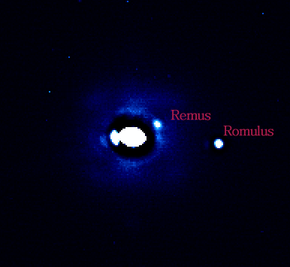
Back Ròmul (satèl·lit) Catalan Romulus (Mond) German Ρωμύλος (δορυφόρος) Greek رومولوس (قمر) Persian Romulus (kuu) Finnish Romulus (lune) French ロムルス (衛星) Japanese 로물루스 (위성) Korean Ромул (Сильвиялӧн тӧлысь) KV Romulus (maan) Dutch
 Adaptive Optics observations of (87) Sylvia, showing its two satellites, Remus and Romulus. | |
| Discovery[1] | |
|---|---|
| Discovered by | |
| Discovery date | 18 February 2001 |
| Designations | |
| Sylvia I | |
| Pronunciation | /ˈrɒmjʊləs/ |
Named after | Rōmulus |
| |
| Main belt (Cybele) | |
| Adjectives | Romulian,[2] -ean[3] (both /rɒˈmjuːliən/) |
| Orbital characteristics[4] | |
| Epoch 1 September 2004 (JD 1795812.5) | |
| 1351.35±0.1 km | |
| Eccentricity | 0.0069±0.0037 |
| 3.6496+0.025 −0.024 d | |
Average orbital speed | 27.0 m/s |
| 167°±23° | |
| Inclination | 1.7°±1.0° (with respect to Sylvia equator) |
| 93.17°±1.85° | |
| 175°±23° | |
| Satellite of | 87 Sylvia |
| Physical characteristics | |
| Dimensions | 10.8±5.6 km[4] |
| Mass | 9.319+20.7 −8.3×1014 kg[4] |
Equatorial escape velocity | ~ 4.8 m/s (estimate) [citation needed] |
| 10.7[5] | |
Romulus is the outer and larger moon of the main-belt asteroid 87 Sylvia. It follows an almost-circular and close-to-equatorial orbit around the asteroid. In this respect it is similar to the other Sylvian moon Remus.
- ^ IAUC 7588, announcing the discovery of S/2001 (87) 1
- ^ Clark (1919) History of Roman private law, v. 3
- ^ Rodríguez-Adrados, van Dijk, & Ray (2000) History of the Graeco-Latin Fable
- ^ a b c Fang, Julia; Margot, Jean-Luc; Rojo, Patricio (16 July 2012). "Orbits, Masses, and Evolution of Main Belt Triple (87) Sylvia". The Astronomical Journal. 144 (2): 70. arXiv:1206.5755. Bibcode:2012AJ....144...70F. doi:10.1088/0004-6256/144/2/70. S2CID 55173059.
- ^ Cite error: The named reference
Marchis05was invoked but never defined (see the help page).